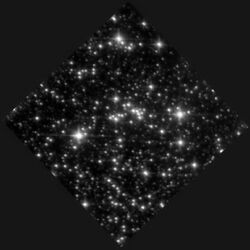Astronomy:1806-20 cluster
| 1806-20 cluster | |
|---|---|
| Observation data (2000 epoch) | |
| Constellation | Sagittarius |
| Right ascension | 18h 08m 39.33s[1] |
| Declination | −20° 24′ 40.0″[1] |
| Distance | ~50000 ly (~15000 pc) |
| Physical characteristics | |
| Notable features | Contains SGR 1806-20 and LBV 1806-20. |
| Other designations | G10.0-0.3, W31 |
1806-20 (originally named the SGR 1806-20 cluster) is a heavily obscured star cluster on the far side of the Milky Way, approximately 50,000 light years distant. It contains the Soft gamma repeater SGR 1806-20 and the luminous blue variable hypergiant LBV 1806-20, a candidate for the most luminous star in the Milky Way. LBV 1806-20 and many of the other massive stars in the cluster are thought likely to end as supernovas in a few million years, leaving only neutron stars or black holes as remnants.
The cluster is heavily obscured by intervening dust, and mostly visible in the infrared. It is part of the larger W31 H II region and giant molecular cloud. It has a compact core of ~0.2 pc in diameter with a more extended halo of ~2 pc in diameter containing the LBV[1] and at least three Wolf–Rayet stars (of types WC8, WN6, and WN7) and an OB supergiant, plus other young massive stars.[2]
See also
- Wolf-Rayet star
- LBV 1806-20
- SGR 1806-20
- Hypergiant
- Star cluster
- Luminous blue variable
- Charles Wolf
- Georges Rayet
References
- ↑ 1.0 1.1 1.2 SIMBAD/Aladin plot, of r=30 asec region around SGR B18054117-20251165
- ↑ D. F. Figer et al. Astrophys. J. 622 (2005) L49-L52
External links
- The Unusual High-Mass Star Cluster 1806-20 [1]


